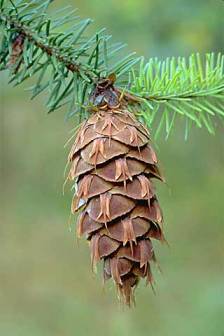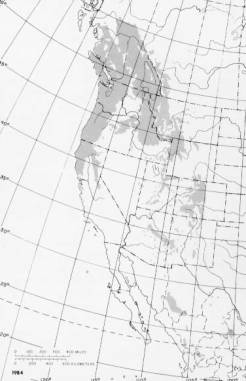Pseudotsuga menziesii (Douglas –Fir)

Picture from: http://my.execpc.com/~mcphoto/smgal/34.html

Range
North from central
British Columbia, all the way south to central Mexico. East to western Montana and Wyoming.
Climate, elevation
A well precipitated
winter with dry months of July and August.
Mostly a mild, continental climate.
Elevation is generally between 550-2,440 m. The
highest altitude it has been found growing is at Mount Graham in
southeastern Arizona where it is 3260 m.
Local occurrence (where,
how common)
Big variety of
occurrences. Dry lower elevation sites
to moist mountainous sites. Bunchgrass
communities to sub alpine forests. Most
commonly found on low-middle elevation forests on all types of slopes, aspects,
landforms, and soils.
Habitat preferences
Well-aerated and
deep soils.
Plant strategy
type/successional stage (stress-tolerator, competitor, weedy/colonizer, seral,
late successional)
Shade tolerant in
dry low-middle elevation forests. It is
shade intolerant in wetter forests. It
is both a climax and seral species by replacing some species but also being
replaced by other species. It is
resistant to fire due to its thick, corky bark. Has naturally survived due to changes in fire regime, climate
variation, and selective logging.
Associated species
Alnus rubra, Pinus ponderosa, Pinus strobiformis, Abies
lasiocarpa var. arizonica, Abies concolor, Picea pungens, Populus
spp., Acer circinatum, Gaultheria shallon, Rhododendron macrophyllum,
Berberis nervosa, Vaccinium parvifolium, Rubus spectabilis, Symphoricarpos
albus, Spirea betulifolia, Physocarpus malvaceus, Pachistima myrsinites
May be collected as:
(seed, layered, divisions, etc.)
Seeds
Collection restrictions or
guidelines
Seeds dispersal
begins around mid August and two-thirds of the seed crop will be dropped by
October.
Seed germination (needs
dormancy breaking?)
Light exposure and
stratification will affect seed germination.
The seeds will germinate naturally on the ground after falling from the
tree.
Seed life (can be stored,
short shelf-life, long shelf-life)
Germination
generally occurs 150 days after seed fall, but will remain viable for 1-2
years.
Recommended seed storage
conditions
Low temperature and
moisture conditions, approximately 5-8% moisture and 7-10o C.
Propagation
recommendations (plant seeds, vegetative parts, cuttings, etc.)
Planting seeds and
growing them in a nursery is the most common and successful way of
propagation. Cuttings have been tried, but
have been unsuccessful. Tissue culture
is emerging and that propagation method is being research at this time.
Soil or medium
requirements (inoculum necessary?)
A moist mineral soil
with a little (~1 inch) organic material.
Installation form (form, potential
for successful outcomes, cost)
Seeds, seedlings
grown in a nursery.
Recommended planting
density
In nature, they
start with about 2500 trees per hectare.
Care requirements after
installed (water weekly, water once etc.)
Water enough to keep
the soil from drying out and continue until the root system of the tree has
been established.
Normal rate of growth or
spread; lifespan
Slow growing for the
first year due to dormancy from late summer to the following spring. Very slow growing past 200 years old. The oldest known tree was located in Mt.
Vernon at 1400 years old, until it was cut down.
Sources cited
1.) http://www.fs.fed.us/database/feis/plants/tree/psemeng/botanical_and_ecological_characteristics.html.
2.) http://www.na.fs.fed.us/spfo/pubs/silvics_manual/Volume_1/pseudotsuga/menziesii.htm.
3.) http://my.execpc.com/~mcphoto/smgal/34.html.
4.) Pojar, Jim, Mackinnon, Andy. Plants of the Pacific Northwest Coast. Canada: Lone Pine, 1994.
Data
compiled by
Kevin Klein 17 April 2003.